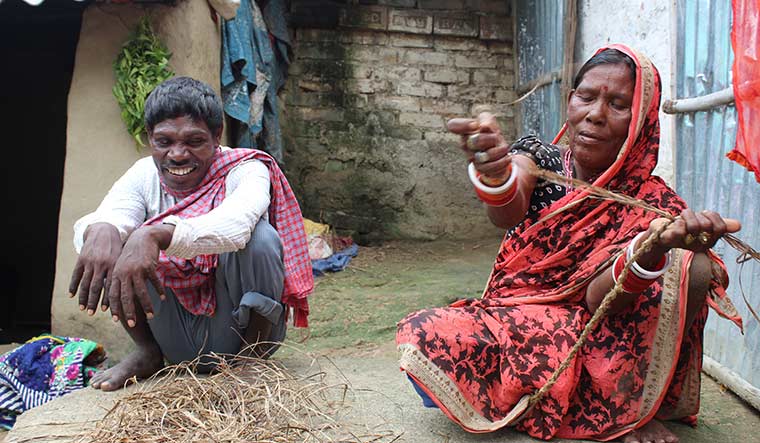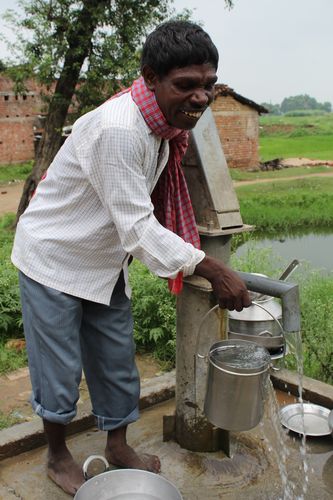THE FIRST TIME Sadhu Manjhi was introduced to the idea of having a toilet of his own, he felt his head spin. “A landless man like me! Imagine that,” he told himself.
Sadhu lives in Bihar, where more than three in five rural households have no land as per the 2011 Socio Economic and Caste Census. He is a member of the Musahar caste—one of the state’s most socially and economically backward groups—listed under the larger category of Mahadalits. Sadhu was born partially blind.
Standing at the intersection of the above three facts, the uneducated 55-year-old is an example of how government schemes can overlook those who are most in need of their benefits. In Sadhu’s case, one such scheme is the Swachh Bharat Mission (SBM), launched in October 2014, to ensure universal sanitation coverage. Though the SBM prioritises persons with disabilities such as Sadhu without land, they are either excluded from its benefits or become just a number in its beneficiary count.
Sadhu’s one-room house in Badauan village, Nimmi panchayat (Fatehpur block), stands by the side of State Highway 70, a busy 58km stretch that connects his home district of Gaya with Rajauli. His wife, Mina Devi, 46, is incapable of walking and drags herself a few feet at a time. The only toilet the couple knew till very recently were the farms some 500m away from their home.
“I have had countless falls since I was a child,” says Sadhu of his daily trek to those fields. Five years ago, he was hit by a tempo and was left with a fractured leg. Mina, who stitches bedcovers from old saris and makes ropes from coconut fibre to add to Sadhu’s income as a singer at weddings, births and celebrations, says, “I feared going to the fields on my own. Many times, I would not eat the whole day to avoid it.”
The challenge of being landless and thus being excluded from government benefits is an oft-repeated lament in Bihar. Maini Manjhi, a 44-year-old mother of eight in Mathna village in Gaya, says, “It is all very well to talk of toilets. But without any land to call one’s own, all conversation about good habits and behaviour change is just talk.” The uneducated and landless Maini’s observation is not just born of her lived reality as a Mahadalit. She speaks also as a flag-bearer of change in her village, where since 2016 she has been an elected ward member of the panchayat. “Toilets offer a sense of security and freedom. But without people owning the land on which they live, those feelings are not possible. It is not enough to just live on a land. You must have the papers to prove that it is yours,” she says.
SBM is only one of many schemes where benefits are hampered owing to landlessness. Till a decade ago, the house construction scheme for the poor—Indira Awas Yojana—was rendered useless to those who did not have land to build a house on, or those who could not prove legal ownership over the homestead they had inhabited for generations.
The Bihar Privileged Persons Homestead Tenancy Act, 1947, provides landless households with permanent and legal ownership of such land on which they have been living continuously for a year, provided they do not own any land elsewhere. As per the 2016-2017 report of the state’s department of revenue and land reforms, since 2009-2010, such land has been provided to 2,38,606 families, of which 88,068 are Mahadalits.
The presence of the law, however, is of no comfort to the residents of Dasli Tola, a tightly-packed hamlet of 350 Musahars in Budhaul. Uday Kumar Bhuiya, 29, has been fighting to get his people a share of their legally entitled land (three decimal for household purposes, as per Bihar’s above-mentioned act) since 2016. No one in his settlement owns any land. Yet Uday can clearly count three generations of his family who have lived in Budhaul. “We are six brothers living in four rooms. Each one of us is married. Land for toilets is a luxury,” says Uday, who gave up studying after a failed attempt at class 12 board exams.
In 2015, many families of the hamlet had their lands identified and measured. Receipts were also handed out. “We had to give a bribe of Rs10,000 to the amin (a survey official of the land department). Some families could not afford any money, so others paid for them. Not a single one of us has got the legal documents to prove land ownership,” says Uday. “The other castes in the village tell us not to get into a useless fight. What our grandfathers did not get, we will not either.”
Also read
- Hola Mohalla: Celebrating martial arts tradition of Sikhs
- Here's the real mission behind B.Tech Paani Puri Wali's business
- G.N. Saibaba's story of hope is also a story of love
- 'We are going through the darkest times I have seen': G.N. Saibaba
- How a unique skilling mission is changing lives of neurodivergent youth
There are only some like Sadhu in Badauan who can see beyond that generational despair stacked against them. For Sadhu, a chance encounter with a local organisation propagating toilet construction prompted him to build his own toilet. He dug a 40-feet pit in a tiny space next to his house. “For five days, I dug. We worked 12 hours a day. We worked till we could move no more,” he says. He then repeatedly demanded the local ward member’s help for accessing the government subsidy for toilet construction.
Sadhu’s toilet is far from ideal. Lack of space means it has just one pit against the mandated two. It does not include conveniences, such as a low-gradient ramp and handrails, which have been suggested by the ministry of drinking water and sanitation in its Handbook on Accessible Household Sanitation for Persons with Disabilities.
And, without a source of running water, Sadhu still makes the dangerous 125-step journey on the busy highway by his home to get to the village hand pump to fetch water, twice a day. If he is not at home and Mina runs out of water, she still avoids food for fear of having to use the toilet. Yet, just like that they are part of the numbers that have contributed to the village’s open defecation free status.
Birendra Kumar Mishra, Bihar’s director of land acquisition, says, “It is true that without land where does one construct a house or a toilet. How does one get benefits of the Indira Awas Yojana? It is all interrelated.” In October 2018, the state government decided to give eligible families Rs60,000 to buy land, and then give them the grant to build a house on it. “It might not seem like much, but it is enough to buy land in rural areas,” Mishra told THE WEEK. “One decimal of land comes at Rs20,000.” He, however, adds that the number of beneficiaries of the new scheme is still to be counted.
Sadhu says that owning land of their own does not figure in his dreams. “We are small people. This little is enough,” he says, as he strikes his red tambourine to sing a song he composed in praise of toilets.



